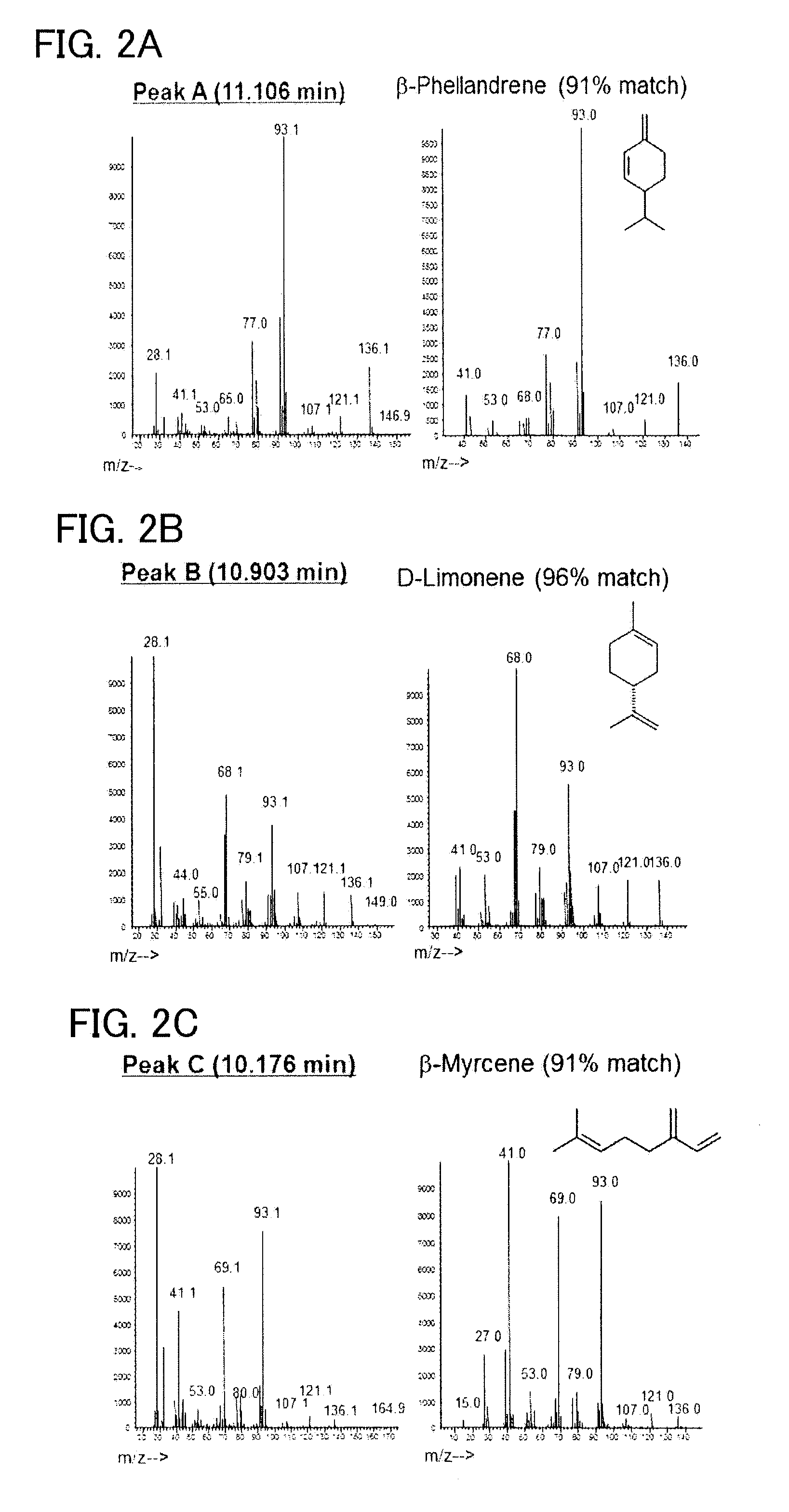Recombinant cell, and method for producing beta-phellandrene
a technology of recombinant cells and betaphellandrene, which is applied in the direction of lyase, transferase, enzymology, etc., can solve the problems of difficult to obtain -phellandrene with high purity, difficult to examine the polymer properties and the like of -phellandrene, and achieve high purity and large quantity
- Summary
- Abstract
- Description
- Claims
- Application Information
AI Technical Summary
Benefits of technology
Problems solved by technology
Method used
Image
Examples
example 1
[0102]In the present example, a recombinant E. coli into which NPP synthase gene from tomato and β-phellandrene synthase gene from tomato were introduced was prepared, and the recombinant E. coli was cultured to produce β-phellandrene.
[0103](1) Isolation of NPP Synthase Gene Derived from Tomato
[0104]Using total RNA derived from tomato (Solanum lycopersicum) as a template, a nucleic acid encoding NPP synthase from tomato (NPP synthase gene from tomato, SEQ ID NO: 3, GenBank Accession No.: FJ797956) was amplified by RT-PCR using primers represented by SEQ ID NO: 9 and SEQ ID NO: 10. The obtained nucleic acid was cut with NdeI and EcoRI, and introduced into pET23a vector (available from Novagen). The nucleotide sequence of the nucleic acid introduced into the vector was examined and correctness was confirmed. In this manner, vector pT21TNPP to express NPP synthase from tomato was prepared.[0105](2) Isolation of β-Phellandrene Synthase Gene Derived from Tomato
[0106]Using total RNA deriv...
example 2
[0116]In the present example, a recombinant E. coli into which GPP synthase gene from Arabidopsis thaliana and β-phellandrene synthase gene from lavender were introduced was prepared, and the recombinant E. coli was cultured to produce β-phellandrene.
[0117](1) Isolation of GPP Synthase Gene Derived from Arabidopsis thaliana
[0118]Using total RNA derived from Arabidopsis thaliana as a template, a nucleic acid encoding GPP synthase from Arabidopsis thaliana (GPP synthase gene from Arabidopsis thaliana, SEQ ID NO: 1, GenBank Accession No.: Y17376) was amplified by RT-PCR using primers represented by SEQ ID NO: 13 and SEQ ID NO: 14. The obtained nucleic acid was cut with NdeI and EcoRI, and introduced into pET23a vector (available from Novagen). The nucleotide sequence of the nucleic acid introduced into the vector was examined and correctness was confirmed. In this manner, vector pT23AGPP to express GPP synthase from Arabidopsis thaliana was prepared.
[0119](2) Isolation of β-Phellandre...
example 3
[0130]In this example, a recombinant yeast into which NPP synthase gene from tomato and β-phellandrene synthase gene from tomato were introduced was prepared, and the recombinant yeast was cultured to produce β-phellandrene.
[0131](1) Isolation of NPP Synthase Gene Derived from Tomato
[0132]Using total RNA derived from tomato as a template, a nucleic acid encoding NPP synthase from tomato (NPP synthase gene from tomato, SEQ ID NO: 3, GenBank Accession No.: FJ797956) was amplified by RT-PCR using primers represented by SEQ ID NO: 13 and SEQ ID NO: 14. The obtained nucleic acid was cut with BamHI, and then introduced into pPIC3.5K vector (available from Invitrogen). The nucleotide sequence of the nucleic acid introduced into the vector was examined and correctness was confirmed. In this manner, vector pP3.5TNPP to express NPP synthase from tomato was prepared.
[0133](2) Isolation of β-Phellandrene Synthase Gene Derived from Tomato
[0134]Using total RNA derived from tomato as a template, a...
PUM
| Property | Measurement | Unit |
|---|---|---|
| Fraction | aaaaa | aaaaa |
| Mass | aaaaa | aaaaa |
| Mass | aaaaa | aaaaa |
Abstract
Description
Claims
Application Information
 Login to View More
Login to View More - R&D
- Intellectual Property
- Life Sciences
- Materials
- Tech Scout
- Unparalleled Data Quality
- Higher Quality Content
- 60% Fewer Hallucinations
Browse by: Latest US Patents, China's latest patents, Technical Efficacy Thesaurus, Application Domain, Technology Topic, Popular Technical Reports.
© 2025 PatSnap. All rights reserved.Legal|Privacy policy|Modern Slavery Act Transparency Statement|Sitemap|About US| Contact US: help@patsnap.com


